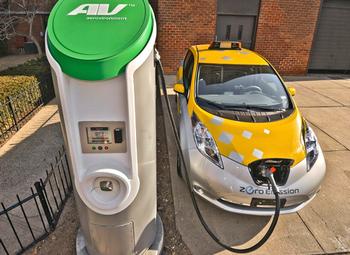
SACRAMENTO, California, May 30, 2014 (ENS) – An alliance of eight U.S. states Thursday announced a plan to put 3.3 million zero emission vehicles on the road by the year 2025 and establish a fueling infrastructure to support this number of vehicles.
The alliance behind the Multi-State ZEV Action Plan includes: California, Connecticut, Maryland, Massachusetts, New York, Oregon, Rhode Island and Vermont.
Their goal is to reduce greenhouse gas and smog-causing emissions by transforming the transportation sector over the next 11 years by encouraging the adoption of ZEVs – plug-in hybrids, battery electric and hydrogen-powered fuel cell electric vehicles. Currently there are just 200,000 ZEVs on U.S. roads.
“Today, we’re putting a foot on the pedal to get more clean cars on the road,” said California Governor Jerry Brown. “This is real action to reduce greenhouse gas emissions.”
With states on the both the Atlantic and Pacific coasts, the eight partner states account for 27 percent of the nation’s new car sales.
“The multi-state ZEV group now has an action plan to guide us through development and deployment of zero emission vehicle infrastructure on both coasts,” said Vermont Governor Peter Shumlin. “Building a robust market for these ultra clean and efficient vehicles, and developing recharging stations and other infrastructure that supports them, will make Vermont and our nation more prosperous by saving drivers money on transportation costs, encouraging economic growth, and reducing motor vehicle pollution impacts on public health and the environment.”
At the core of the Multi-State ZEV Action Plan are 11 key actions to be taken by all the partners.

The key actions cover three main areas:
Build the market
- Promote the availability and effective marketing of ZEVs
- Encourage private fleets to acquire ZEVs
- Promote planning and investment in ZEV infrastructure
- Increase the number of ZEVs in government vehicle fleets
Provide consistent codes, standards and tracking
- Remove barriers to charging station installation
- Provide clear and uniform signage
- Track and report progress toward the 3.3 million vehicle goal
Improve the experience
- Promote workplace charging
- Provide consumer incentives for the purchase of ZEVs
- Remove barriers to retail sale of electricity as vehicle fuel
- Promote access and compatibility for charging networks
The eight states agreed to evaluate the need for, and effectiveness of, monetary incentives to reduce the upfront purchase price of ZEVs and non-monetary incentives, such as access to high-occupancy vehicle lanes, reduced tolls and preferential parking.
These states will implement consistent statewide building codes and standards for charging infrastructure and develop streamlined metering options for homes equipped with electric vehicle chargers.
They agreed to evaluating opportunities to reduce vehicle operating costs and increase electric system efficiency through time-of-use electricity rates and net metering for electric vehicles, and strengthening the connection between ZEVs and renewable energy.
The governors of the eight states began this collaboration with the signing of a Memorandum of Understanding on October 24, 2013.
Since the MOU was signed, state regulators, the auto industry and infrastructure developers and other stakeholders have shared information and best practices to help move the effort forward.
To date, automakers have rolled out more than two dozen models of plug-in hybrids, battery electric and hydrogen-powered fuel cell vehicles. Sales have doubled over the past year alone, with more than half of those sales occurring in the eight states that signed the October 2013 MOU.
The eight-state ZEV Action Plan details steps individual states may take and provides examples of successful existing state programs to improve the experience of ZEV drivers and owners.
“Creating a strong and robust market for zero emission vehicles is critically important to the success of clean-energy technologies, and I am proud that New York is joining these other states to make that a reality,” said New York Governor Andrew Cuomo. “Here in New York, we will be supporting that effort through the Charge NY initiative by installing 3,000 electric vehicle charging stations – vital to the growth of a completely wired Northeast Corridor – and I am hopeful that more States will join this collaborative effort and help pave the way for the clean transportation options of the future.”
Affordable, readily available ultra-clean vehicles are critical to reduce greenhouse gas emissions and lessen the impact of climate change, since the transportation sector is one of the nation’s major sources of greenhouse gases.
Maryland Governor Martin O’Malley said, “This collaborative effort is an important step forward to ensure the success of our zero-emission vehicle programs. Transitioning our light duty transportation fleet to zero emission vehicles is essential if we are to achieve our long term air quality and climate goals.”
Creating a growing market for ZEVs also provides a range of economic benefits. Electricity is widely available, and costs less than gasoline or diesel on a per-mile basis. Maintenance costs for a ZEV are also lower over the life of the vehicle. The push for clean vehicles has also brought investment in new business and jobs which will help put the U.S. economy on a more sustainable footing.
Connecticut Governor Dannel Malloy called the plan “a triple win for participating states because it brings energy, environmental, and economic benefits.”
“Under the blueprint provided in this plan,” said Malloy, “we will continue with our efforts to provide a convenient network of charging stations for electric vehicles, add EVs and fuel cell vehicles to the state’s fleet, and build out the hydrogen infrastructure needed for fuel cell vehicles expected to be available for the 2015 model year.”
The Multi-State ZEV Action Plan is available at: http://bit.ly/1pBhGNU
The 8-State Memorandum of Understanding can be found here: http://bit.ly/1k4tAk4
Copyright Environment News Service (ENS) 2014. All rights reserved.
© 2014, Environment News Service. All rights reserved. Content may be quoted only with proper attribution and a direct link to the original article. Full reproduction is prohibited.
